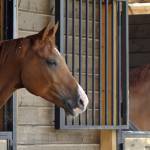Risk Factors for Colic In Horses

Nutrition and particularly changes in feeding are often associated with colic. Several survey-based studies have been performed to better determine what roles diet and dietary changes play in the incidence of colic. A case-matched survey study performed by Noah Cohen, D.V.M., Ph.D., and coworkers at Texas A&M University identified the following risk factors that increased the chances of a horse being treated for a colic emergency.
1. Changing the horse’s diet within the previous two weeks increased the chances of colic 6.6 times.
2. Recent change in type of hay within the previous two weeks was the only specific dietary change that was significantly associated with an increased risk for colic (29.5 times).
3. History of previous abdominal surgery for colic increased the risk of colic by 5.8 times. Horses that have had previous abdominal surgery for colic can sometimes develop adhesions (scar tissue) that prevents normal movement of their intestines.
4. Chances of colic were increased 3.1 times if there was a substantial change in weather conditions in the previous three days. The exact weather change was not further described.
5. A change in housing within the two weeks before being treated for colic almost doubled (1.9 times) the chance of colic.
6. Arabian horses were 1.7 times more likely to be treated for colic than other breeds. Arabians were also more likely to be examined for colic in other studies.
7. Deworming within 7 days prior to colic increased the chances of colic by 1.8 times. However, horses that were regularly dewormed had a decreased risk of colic.
8. Horses that were kept in stalls greater than 50% of the time were 1.2 times more likely to colic than horses that were turned out greater than 50% of the time. Horses that were kept on pasture were significantly less likely to colic.
9. A change in activity during the two weeks before being examined for colic doubled (2.2 times) the chance of colic.
Other studies have also associated a recent change in diet with an increased risk of colic. This emphasizes the importance of feeding a consistent source of hay and making gradual changes when changing feedstuffs. Mature hay will have a higher fiber content that will lower its digestibility and possibly cause impaction colic. Hay quality and maturity can fluctuate widely.
This study also showed that a recent change in diet, particularly hay, was associated with colic. Any dietary change should be made slowly over 7-10 days, and if hay from a different source must be fed, the amount should be gradually increased as the previous hay is depleted.
Reference: Cohen, N.D., P.G. Gibbs, and A.M. Woods. 1999. Dietary and other management factors associated with colic in horses. Journal of the American Veterinary Medical Association 215:53-60.








